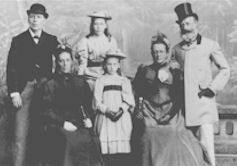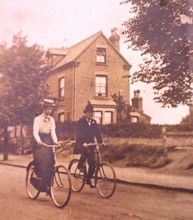| Home Topics Memorials Miscellany Transcripts References Family History Glossary Latest Beeston Blog About us | Site Search |
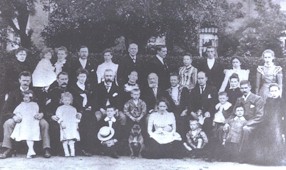
The Extended Thornhill Family |
A History of the Thornhill Family in Beeston - continuedThe Next Generation - William Junior's surviving
children were to have mixed fortunes in their own careers and family lives :
Mary Ann Thornhill was born on 7th July 1859. Continuing the trend for early marriage within the family, Mary was just twenty when she married Thomas Henry Hogg, a hosier's assistant, in 1879. Thomas was the son of Robert Hogg, a solicitor's managing clerk and his first wife Ellen. In 1877, Robert had remarried and, by 1881, was living in the exclusive St Johns Grove area of Beeston and already had a son and daughter by his second young wife before again becoming a widowed in 1889. Meanwhile, Thomas and Mary and their family - they had six children in all - lived in Moorgate, Beeston but,sometime around 1895, moved to Fiskerton, Notts where they appear to have lived out their lives. This property, which included four acres of land, was owned by William Thornhill and had been used by him as a summer cottage. After his death in 1910, the property was left to Mary and her husband for life and then to their children absolutely. 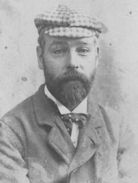 Isaac Thornhill, born on 29th October 1861, was to become a worthy successor to his father and grandfather in
continuing the family tailors business. At an early age he was sent to the prestigious London firm of "Ministers"
to learn cutting but returned to Beeston to eventually take over the business with the same flamboyant,
larger-than-life style and astute manner as his father. He married "the girl next door" - Emily Hind Barnes,
Isaac Thornhill, born on 29th October 1861, was to become a worthy successor to his father and grandfather in
continuing the family tailors business. At an early age he was sent to the prestigious London firm of "Ministers"
to learn cutting but returned to Beeston to eventually take over the business with the same flamboyant,
larger-than-life style and astute manner as his father. He married "the girl next door" - Emily Hind Barnes,
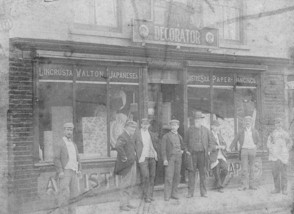 daughter of William Barnes who ran a successful family painting and decorating business from premises on adjacent
to the Thornhill business on High Road, on the corner of Villa Street.(See the photo on the right - click the
image for details) The Barnes family were Baptists - William
was a preacher. Isaac, however, remained a faithful attender at the Parish Church. Continuing the habit of active
benevolence which was a characteristic of his father,it is said that he would buy shoes for any child who he
discovered had none. In his early days with the firm, he would often cycle to visit clients but later owned a motor
cycle - the first in the area. The family property on High Road had included accommodation for two families as
well as the shop and workrooms but after William and Rosa moved to North Street and Isaac's family was the only one
living there, the opportunity was taken, in 1899, to sell the unused part of the frontage to enable the Co-operative
Society to open its first shop in Beeston; eventually this enterprise was to acquire the whole property as well as
the Barnes' premises where it developed a large grocery store which continued until the 1980's when it closed and
was redeveloped.
daughter of William Barnes who ran a successful family painting and decorating business from premises on adjacent
to the Thornhill business on High Road, on the corner of Villa Street.(See the photo on the right - click the
image for details) The Barnes family were Baptists - William
was a preacher. Isaac, however, remained a faithful attender at the Parish Church. Continuing the habit of active
benevolence which was a characteristic of his father,it is said that he would buy shoes for any child who he
discovered had none. In his early days with the firm, he would often cycle to visit clients but later owned a motor
cycle - the first in the area. The family property on High Road had included accommodation for two families as
well as the shop and workrooms but after William and Rosa moved to North Street and Isaac's family was the only one
living there, the opportunity was taken, in 1899, to sell the unused part of the frontage to enable the Co-operative
Society to open its first shop in Beeston; eventually this enterprise was to acquire the whole property as well as
the Barnes' premises where it developed a large grocery store which continued until the 1980's when it closed and
was redeveloped.Eliza Sylvia Thornhill - known as Sylvia - was born on 14th May 1863. As we have seen, for some reason she was sent, at a young age, to live with her uncle and aunt in Birmingham - William Ragg and his wife Sylvia. While there she met Edward Tracey who was then working as an iron merchants clerk at the start of what was to become a "rags-to-riches-and-back-to-rags" story. He was the second of four sons of William Tracey who has been described as a work-shy gardener. At that time he was living with his parents at 6 Wheeleys Lane in Birmingham which crosses Islington Row and so would have been a near neighbour of Sylvia and they became acquanted. It seems that, once more, we see the now familiar pattern within the family of early marriage - but, this time, with some apparent parental resistance as they married the day after her 21st birthday - although back within the family at Beeston. Despite his 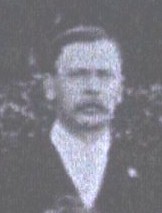 unpromising background, Edward (shown left in 1901) was an ambitious man who made a series of advantageous career moves, until he became
Company Secretary to British Insulated Cables in Prescott, Lancashire and became popular with Lord Derby, a director
of the company - so beginning an era in which the couple lived in high social circles. During this time, Sylvia became
friendly with Lady Derby who would arrive in her carriage to take her on shopping expeditions and, when the Prince and
Princess of Wales visited Knowsley Hall at the turn of the century, William and Sylvia were guests at the ball held in
honour of the royal visitors. Then, within a year,something caused William, with his wife and their two sons to leave
for Melbourne, Australia, arriving on November 7 1901. In fact, it appears that Edward and Sylvia may have visited
there ealier in that year as they do not appear anywhere on the census that was taken on March 1, 1901 but, at that
time, Sylvia's older sister Mary ("Aunt Polly") is to be found at the family home in Whiston, Lancs, apparently
caring for the boys while their parents are away. If Melbourne was also their destination then, there may have been
an easy explanation; in May of that year, that city was the place to be - on the 9th of that month, the various
States of Australia combined in a Federal government and "Marvellous Melbourne", was then considered Australia's premier
city in terms of wealth and growth and thus became the Nation's capital - a status which continued up to 1927 when
Canberra was complete. To an ambitious man like Edward, this may have been irrisistable and he may therfore have
insisted that they return to England, collect their family and return. Whatever the reason, it turned out to be
unpromising background, Edward (shown left in 1901) was an ambitious man who made a series of advantageous career moves, until he became
Company Secretary to British Insulated Cables in Prescott, Lancashire and became popular with Lord Derby, a director
of the company - so beginning an era in which the couple lived in high social circles. During this time, Sylvia became
friendly with Lady Derby who would arrive in her carriage to take her on shopping expeditions and, when the Prince and
Princess of Wales visited Knowsley Hall at the turn of the century, William and Sylvia were guests at the ball held in
honour of the royal visitors. Then, within a year,something caused William, with his wife and their two sons to leave
for Melbourne, Australia, arriving on November 7 1901. In fact, it appears that Edward and Sylvia may have visited
there ealier in that year as they do not appear anywhere on the census that was taken on March 1, 1901 but, at that
time, Sylvia's older sister Mary ("Aunt Polly") is to be found at the family home in Whiston, Lancs, apparently
caring for the boys while their parents are away. If Melbourne was also their destination then, there may have been
an easy explanation; in May of that year, that city was the place to be - on the 9th of that month, the various
States of Australia combined in a Federal government and "Marvellous Melbourne", was then considered Australia's premier
city in terms of wealth and growth and thus became the Nation's capital - a status which continued up to 1927 when
Canberra was complete. To an ambitious man like Edward, this may have been irrisistable and he may therfore have
insisted that they return to England, collect their family and return. Whatever the reason, it turned out to be
 catastrophic as William, then only 40, was at the height of his career and Sylvia resisted going - and, once there,
did not rest until they had booked their return passage. Perhaps, a clue lies in a passage in memoirs written late
in his life by their son, Cyril Edward Tracey; describing a holiday spent at his Aunt Polly's (Mary Ann Hogg nee
Thornhill) home at Fiskerton in the Summer of 1898, when he wrote, "Dad stayed a week, and the rest of us about
three weeks, and I noticed at this time Dad was getting very fond of his drinks, so in the evening we went a short
walk to a tiny village, Morton-cum-Fiskerton, where there was a pub called "The Moon", with a painted sign. Dad had
his whisky and me pop". Soon after their arrival, they did return - probably in 1902 - and their marriage broke up,
Edward abandoned his family, his career suffered and he died in very humble circumstances in 1953. After the breakup,
Sylvia (shown right, later in life) was left with their two sons - Sidney Thornhill Tracey, who was about 7 and, critically, Cyril Edward Tracey
who was aged about 15, and at a critical stage of his life. Recognising this, William and Rosa Thornhill, took
charge and accommodated the young man at their home in Beeston and launched him into a career by arranging for him
to be apprenticed at the Nottingham firm of Goddard, Massey & Warner who were Engineers and Iron Founders - and, as
a result we have his account, recalled late in life in his memoir:
catastrophic as William, then only 40, was at the height of his career and Sylvia resisted going - and, once there,
did not rest until they had booked their return passage. Perhaps, a clue lies in a passage in memoirs written late
in his life by their son, Cyril Edward Tracey; describing a holiday spent at his Aunt Polly's (Mary Ann Hogg nee
Thornhill) home at Fiskerton in the Summer of 1898, when he wrote, "Dad stayed a week, and the rest of us about
three weeks, and I noticed at this time Dad was getting very fond of his drinks, so in the evening we went a short
walk to a tiny village, Morton-cum-Fiskerton, where there was a pub called "The Moon", with a painted sign. Dad had
his whisky and me pop". Soon after their arrival, they did return - probably in 1902 - and their marriage broke up,
Edward abandoned his family, his career suffered and he died in very humble circumstances in 1953. After the breakup,
Sylvia (shown right, later in life) was left with their two sons - Sidney Thornhill Tracey, who was about 7 and, critically, Cyril Edward Tracey
who was aged about 15, and at a critical stage of his life. Recognising this, William and Rosa Thornhill, took
charge and accommodated the young man at their home in Beeston and launched him into a career by arranging for him
to be apprenticed at the Nottingham firm of Goddard, Massey & Warner who were Engineers and Iron Founders - and, as
a result we have his account, recalled late in life in his memoir:"For the first two nights I had to share the bedroom (at Middleton House) with Ted Boot, Grandma Rosa's younger son, On the August Bank Holiday he married a very nice girl, Margaret Price, the eldest of a family of nine girls. Her father was senior signal-man at Beeston station. After that I had the bedroom to myself. During this week I didn't go to work *************** Caroline Elizabeth Thornhill was William and Eliza's sixth child, born on the 9th August 1864. Her mother died she was only 11 but had four surviving younger brothers and accommodation must have fairly cramped at the High Road home. Perhaps the traditional role of the youngest daughter - caring for the household - did not appeal as, for whatever reason, once again we see an early marriage in the family. Caroline was 19 when she married the 25-year-old Frank Walker, a clerk at Pearsons Nurseries in Chilwell, just over Beeston's western boundary. In this occupation,Frank was following in the footsteps of his father, Thomas, who had occupied that position 30 years earlier and was, by 1861 the manager at Pearsons. Caroline and Frank's first child, Florence Emily was born at Chilwell in the following year but soon after this, Frank took his family to live in Tottenham, London where two sons were born. By 1891, the family had moved again, to St Albans in Hertfordshire where he was employed as a clerk. A further move then took them to Sculcoates, a suburb of Hull from where he worked as a cashier to a Leeds warehouseman. In later life, possibly helped by Caroline's inheritance from her father's estate following his death in 1910, the family moved to the village of Keyingham, just to the east of Hull, on the road to Spurn Head and north of the Humber Estuary. It is there that a nice post-script was played out - at her father's funeral, in February 1910, his pony and trap had followed the bearers to the church; although, getting on in years, this pony - Rodger - lived out its remaining years pulling the same trap around the byways of East Yorkshire. Charles William Thornhill was born on 14 February 1866. He left the family home early, apparently to set himself up as a baker in Long Eaton, presumably after the usual apprenticeship. He then moved to Lancashire where he married, soon after his 21st birthday in 1887, to Mary Crookes. He continued to work in the Salford area until after 1901, during which time they had their only child, William Walter. On 24 December 1909 they left England on the Osterley, a steamship of the Orient Line, bound for Australia where there settled in New South Wales and where Charles died in 1937. 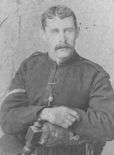 Walter Bryan Thornhill, born on the 31st January 1868, joined the Army and spend several years serving in India
in the Royal Artillery (see picture right, taken during his time in India), eventually attaining the rank of Sergeant-Major. In
1897 he married Annie Mary Thornhill who, although born in Beeston, was not apparently related. By the following year, they were living in Dover,
Kent were he was stationed and where at least two of their three children were born. After leaving the Army, Walter and his family settled in
Mansfield, Notts where he took a position of School Attendance Officer until his death there in 1928.
Walter Bryan Thornhill, born on the 31st January 1868, joined the Army and spend several years serving in India
in the Royal Artillery (see picture right, taken during his time in India), eventually attaining the rank of Sergeant-Major. In
1897 he married Annie Mary Thornhill who, although born in Beeston, was not apparently related. By the following year, they were living in Dover,
Kent were he was stationed and where at least two of their three children were born. After leaving the Army, Walter and his family settled in
Mansfield, Notts where he took a position of School Attendance Officer until his death there in 1928.Joseph William Thornhill was the youngest of William and Eliza's children to survive into adulthood. He was born on 3rd February 1873 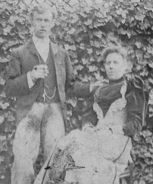 and was only two when his mother died. After school, he was placed as apprentice to a barber in Market Harborough - although things
did not go entirely smoothly. One Sunday evening, the family were in Church at Beeston as usual when a whisper ran around the
congregation, "Joe's come home !". Apparently, he had been used more as domestic help to the barber's family so had
run away to complain. William is said to have taken him back, had a showdown with the barber and subsequently placed
him in London to complete his apprenticeship. Once this was over, William set him up in business at 62 High Road, Beeston -
more recently occupied by Dillons - opposite the Greyhound Public House. The business appears to have prospered as he
later employed another man and a lather boy and expanded into tobacco, newspapers, a library and fancy goods - and even
opened up a bathroom upstairs where local workmen could have a bath for 6 pence ! In 1894, he married Louisa Waddington from Lincolnshire
(shown together, left) and they had two daughters. He was later to open another shop on Queens Road, Beeston but eventually
the family left Beeston and he then operated from Eland Street, Basford, Nottingham.
and was only two when his mother died. After school, he was placed as apprentice to a barber in Market Harborough - although things
did not go entirely smoothly. One Sunday evening, the family were in Church at Beeston as usual when a whisper ran around the
congregation, "Joe's come home !". Apparently, he had been used more as domestic help to the barber's family so had
run away to complain. William is said to have taken him back, had a showdown with the barber and subsequently placed
him in London to complete his apprenticeship. Once this was over, William set him up in business at 62 High Road, Beeston -
more recently occupied by Dillons - opposite the Greyhound Public House. The business appears to have prospered as he
later employed another man and a lather boy and expanded into tobacco, newspapers, a library and fancy goods - and even
opened up a bathroom upstairs where local workmen could have a bath for 6 pence ! In 1894, he married Louisa Waddington from Lincolnshire
(shown together, left) and they had two daughters. He was later to open another shop on Queens Road, Beeston but eventually
the family left Beeston and he then operated from Eland Street, Basford, Nottingham.
|
|
